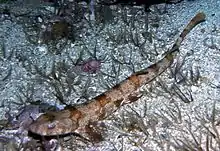
The puffadder shyshark or happy Eddie, Haploblepharus edwardsii, is a species of catshark, family Scyliorhinidae, endemic to the temperate waters off South Africa. This common shark is found on or near the bottom in sandy or rocky habitats, from the intertidal zone to a depth of 130 m (430 ft). Typically reaching 60 cm (24 in) in length, the puffadder shyshark has a slender, flattened body and head. It is strikingly patterned with a series of dark-edged, bright orange "saddles" and numerous small white spots over its back. The Natal shyshark (H. kistnasamyi), formally described in 2006, was once considered to be an alternate form of the puffadder shyshark.
When threatened, the puffadder shyshark (and other members of its genus) curls into a circle with its tail covering its eyes, giving rise to the local names "shyshark" and "doughnut". It is a predator that feeds mainly on crustaceans, polychaete worms, and small bony fishes. This shark is oviparous and females deposit egg capsules singly or in pairs onto underwater structures. Harmless to humans, the puffadder shyshark is usually discarded by commercial and recreational fishers alike for its small size. It has been assessed as Near Threatened by the International Union for Conservation of Nature (IUCN), as its entire population is located within a limited area and could potentially be affected by a local increase in fishing pressure or habitat degradation.